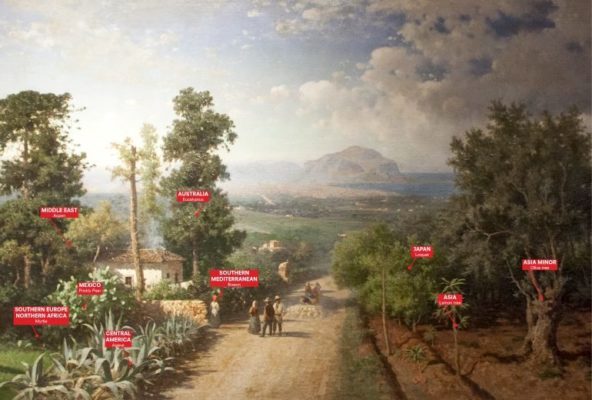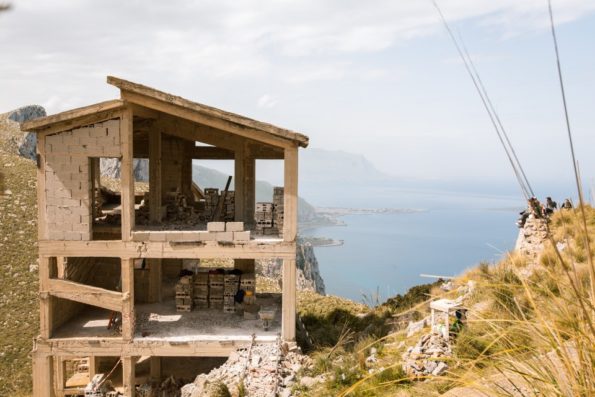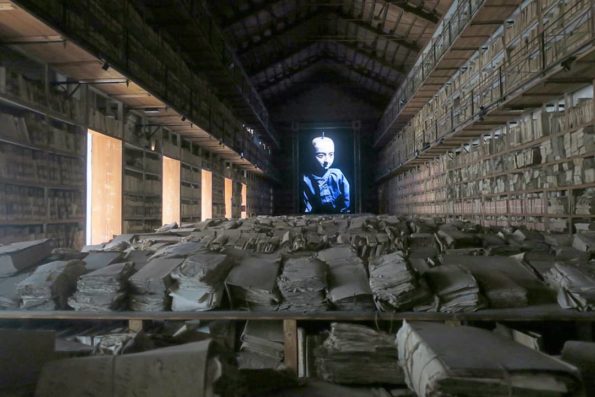Search
To search for an exact match, type the word or phrase you want in quotation marks.
A*DESK has been offering since 2002 contents about criticism and contemporary art. A*DESK has become consolidated thanks to all those who have believed in the project, all those who have followed us, debating, participating and collaborating. Many people have collaborated with A*DESK, and continue to do so. Their efforts, knowledge and belief in the project are what make it grow internationally. At A*DESK we have also generated work for over one hundred professionals in culture, from small collaborations with reviews and classes, to more prolonged and intense collaborations.
At A*DESK we believe in the need for free and universal access to culture and knowledge. We want to carry on being independent, remaining open to more ideas and opinions. If you believe in A*DESK, we need your backing to be able to continue. You can now participate in the project by supporting it. You can choose how much you want to contribute to the project.
You can decide how much you want to bring to the project.

‘Together, let us assume that the Earth is one small garden.’ This statement by landscape architect and philosopher Gilles Clément, taken from Le Jardin Planétaire (‘The Planetary Garden’ manifesto, 1999), starts from the idea that we are living in a sort of Garden of Eden that as human beings we guard, and whose diversity and sustainability we must preserve. Now let’s zoom into the Mediterranean, to a spot located between Africa, Europe and the Middle East — Sicily, its greatest island. Over the course of history, Sicily has been dominated by Phoenicians, Greeks, Carthaginians, Romans, Byzantines, Arabs, Normans, Spanish, Austrians and French, all of whom left cultural and architectural marks.

The flux of peoples brought new religions, cultures, languages and plant seeds that have produced a hybrid vegetation domesticated by the mild Mediterranean climate and expressed in the Romantic painting Veduta di Palermo by Lojacono, in which none of the natural elements represented is autochthonous[i]. Even the citrus fruits that are so typical today were introduced during the Arab domination. All this, together with the work by the radical author Clément (from which it has taken its title) has inspired the twelfth nomadic European biennale Manifesta held this year in Palermo. The virtues and vices of this Manifesta, attuned to a theme that is as elusive as it is fascinating – the idea of a city as a planetary garden that welcomes all – will be difficult to forget. A metaphor (or a utopia, in view of the migratory policies of the First World, particularly those enforced by Salvini, the new Italian Minister of the Interior[ii] of our global society, and of that of Palermo in particular, a syncretic cultural melting pot.
Palermo’s oratori and palazzi, showing the scars of abandonment, bandaged and reinforced, have challenged artists from around the world. I wonder whether the members of the heterogeneous curatorial team – now referred to as ‘creative mediators’ under the direction of Sicilian architect Ippolito Pestellini, partner at OMA, and along with Andrés Jaque – ever imagined that the city would respond so generously to the suggestion of opening up to the contemporary. I also wonder whether they had foreseen that the grande bellezza of Palermo would put our ability to concentrate on contemporary pieces, dazzled by architecture and light, to the test. Whether they had foreseen that the languid scale of the venues chosen ran the risk of obscuring the rigorous social messages that many artists had consigned to their films (fantastic films such as those by U. Orlow, L. Poitras, Masbedo, Y. Ancarani and Alterazioni Video), that required the sacrifice of sitting in the dark and wearing headphones to think of migration, human traffic, climate change, mafia or technological border control.
Indeed, the invasion of contemporaneity is shockingly disappointing at the San Lorenzo Oratory, where Nora Turato has placed a hideous black metal cage. In this delicate space, filled with eighteenth-century stucco by Serpotta where saints and putti already speak of fragile tortured bodies, the Croatian artist presented her performance on mistreated women, breaking the silence with a litany in English. This piece forms a part of the City on Stage section, that otherwise comprises some of the most convincing works in the biennale such as the moderate gestures of Da Quassù È Tutta Un’altra Cosa by the Belgian collective Rotor. In the late seventies and under the wing of the mafia, building licences were issued for developing Pizzo Sella, dubbed ‘the hill of shame’ in Monte Gallo national park. The construction of 170 villas began, only to be aborted by the city council in 1997. The villas were never demolished, however, and have been the object of numerous legal battles. Visible from the road, the concrete skeletons have been chosen by Rotor as the site of their intervention, which consists in underpinning one of these structures to transform it into a vantage point. On one side we see the undulating Mediterranean coastline, and on the other, the urban expansion of Palermo. The work thus addresses the legality, possibility, function and occupation of natural and social elements with regard to urban planning and settings and reminds me of Chantier Permanent (Permanent Construction Site, 1993) by Pierre Huyghe[iii], a project dedicated to unfinished buildings along the Italian Mediterranean coast, skeletons of houses that remain as such after being purchased, which could be seen as a kind of fraud.

The sand-coloured blocks of Zona Espansione Nord (ZEN), a social housing area designed by Vittorio Gregotti and inspired by the walled city, can be seen from the vantage point and looks more like a fortress, or a prison. In spite of the architect’s utopian aspirations, it soon became fodder for organised crime, unemployment and poverty. The English collective Coloco, together with the aforementioned Clément, have created a community garden. The good thing about this site-specific project is that it calls on local residents for triggering change in the complex legal, social and ecological framework in this deteriorated part of the city.
Back in the city, in the Istituto Padre Messina opposite the port we find the video-installation New Palermo Felicissima by Jordi Colomer. On the screen, a small group of people visit the city’s south coast by boat, a touristic paradise that is now polluted. A young tourist guide played by a professional actress recites texts by writer Roberto Alajmo dictated through an earpiece. In this work, fiction, oral history and community are seen from the undulating perspective of those beholding the land from the sea.
The Palazzo Ajutamicristo, built in the fifteenth century around a courtyard of roses, figs and palm trees, welcomes works that focus on transnational networks, where everything can be moved (finance, information and even fuel), except people. The Third Choir, a piece by the young Algerian artist Lydia Ouhramane, emits a buzz. It consists of oil barrels inside which mobile phones ring in unison, perhaps as a reminder of the illegal business of human trafficking. The drums are the first work of art Algeria has exported in forty years due to the strict post-colonial cultural property laws. This work is included in the section entitled ‘Out of Control Room’, as is the piece Connected by Air by Dutch artist Richard Vijgen in the adjacent room. Like many others, Vijgen tackles the subject of global surveillance. In this case, a projection on the ceiling evokes a planetarium that in real time displays data concerning wireless signals, aeroplanes and satellites instead of constellations, reminding us that we are continuously being watched.
In the Moorish Palazzo Forcella De Seta, Forensic Oceanography explores growing militarisation of the Mediterranean and the impact of its necro-policies [iv] in the excellent and extensive video-installation Liquid Violence. Continuing with the work of Forensic Architecture [v],
this year nominated for the Turner Prize, the installation shows navigation charts, ship movements and trailers of abandoned vessels. On one of the walls a graph shows the deaths at sea since 2011. The figure is devastating and the information to be processed is overwhelming. Next to this work we find more uncontrolled human suffering in the film Untitled (Near Parndorf, Austria) by Irish artist John Gerrard, who turns to video-game technology to reconstruct the spot on an Austrian road where in 2015 an abandoned lorry was discovered transporting the suffocated bodies of seventy-one immigrants. The artist’s own memory reveals death as an abstraction when political fortunes are at risk.
If many of the previously mentioned works are excessively literal and documentary in style and remind us of dark realities, the third section, ‘Garden of Flows’, is more utopian in nature and celebrates hope, possibility and beauty. One of its venues is the exuberant Orto Botanico, an illustrated and colonial project founded in 1789 and home to thousands of exotic species, including the giant ficus macrophylla, a sort of plant building that is also found in Piazza Marina. The relationship between man and nature, the anthropocene, appears in the delicate work by Michael Wang: coal, an enchanted forest and a bacteriological attack that produces strange colours in a fountain amidst the vegetation of the botanical garden.
Opposite, Leone Contini’s vegetable garden Foreign Farmers shows the cohabitation of vegetables imported to Sicily by immigrants, an acceptable project though quite simplistic bearing in mind it is the result of ten years’ research. What Is Above Is What Is Below by the artistic duo Cooking Sections is a much more interesting proposal. Using building materials, they revise the dry irrigation techniques inspired by traditional giardini panteschi (island of Pantelleria)[vi]. In Sicily, where for a long time the control of the water has been connected to organised crime and the local economy, mostly agricultural, is now threatened by the droughts produced by climate change, these three structures located in Spasimo, Giardino dei Giusti and Volpe Astuta suggest the possibility of different ways of moving forwards.

In its turn, Theatre of the Sun by the Los Angeles-based duo Fallen Fruit presents a map of all the fruit trees located in the city’s public spaces. Few people notice, because the installation also includes a bright-coloured printed design with the fruit – probably the largest of the Instagrammed works in the biennale – that decorates the walls of a room in the spectacular Palazzo Butera, a jewel of the Sicilian Baroque. From exuberance to the poetic minimalism of Renato Leotta in Notte di San Lorenzo, a subtle evocation of the complexity of the earth. Leotta, though originally from Turin, is the only artist at the biennale who lives in Sicily. His work consists in covering a huge hall of the palace with terracotta paving stones. The marks on the slabs have been caused by lemons dropping from the trees in a citrus fruit orchard he owns in the foothills of Mount Etna. This soil acts as a sort of mirror reflecting the Baroque frescos of the crumbling ceiling, reminding us of the rural economies on which this urban luxury was built, as described by Giuseppe Tomasi de Lampedusa in his magnificent Il Gatopardo (1958), a sumptuous portrait of nineteenth-century feudal Sicily subsequently adapted to film by Visconti.
Manifesta also offers a chance to visit places unknown even in Palermo, as is the case of the Archivio di Stato, a sort of ossuary with a centuries-old history recorded in notarial documents. It was precisely a document dated 1958 accusing director Vittorio De Seta of subversive activities discovered in the archive by Milanese artists Masbedo that inspired the impressively dramatic installation entitled Protocolo n. 90/6 (Protocol No. 90/6) in which the document is illuminated among thousands of dusty heaps of volumes. At the rear, a huge LED screen showing a wooden puppet wearing an electric blue suit, with perforated eyes and a bewildered expression, faces the viewer in silence. The puppet represents De Seta. It’s a shame that this unique and unforgettable piece should only be open to the public for a few days, before the archive will close again.

One of the strengths of this Manifesta in Palermo is the fact that thirty-six new works have been especially commissioned. Many of them have been made in close collaboration with people in the city, considering Palermo as a spatial, cultural, political and historical ‘entity’. The nomadic biennale that turns us into nomads has, once again, achieved its goal, focusing oncomparison, confrontation, surprise and travel understood as immersion in the contradictory and multiform reality that surrounds us. Another excellent man of letters from the island, Gesualdo Bufalino, described Sicily as la luce e il lutto. The city of Palermo is just that, one thing and its opposite — the need to attain a balance between beauty and horror, rationality and delirium, the light of life and the darkness of death. At once refined and decadent, mean-spirited and arrogant, bustling and resigned, it has been and still is hope and fatality but, above all, a city that has no fear of embracing difference, a city open to the world. This is a garden we definitely want to enter.
Manifesta 12 in Palermo (Italy), until 4 November 2018.
[i] ‘The 1875 painting Veduta di Palermo by Francesco Lojacono, kept in the collection of the Galleria d’Arte Moderna Sant’Anna (GAM) in Palermo, features the Asian olive tree, the Middle Eastern quaking aspen, the Australian eucalyptus, the Mexican prickly pear and the Japanese medlar.’ Palermo Atlas (July 2017), an interdisciplinary urban study of the city carried out by the Office for Metropolitan Architecture (OMA) before Manifesta 12 on which the biennial’s curatorial concept is based.
[ii] Matteo Salvini banned the NGO ship Aquarius with 629 migrants on board from entering Italian ports the day of the private opening of Manifesta 12. Leoluca Orlando, mayor of Palermo, announced that the city would welcome the ship, which was subsequently accepted by the Spanish authorities in the port of Valencia.
[iii] http://artdaily.com/news/52410/You-have-been-there–Departures–bifurcations—A-proposition-by-Marie-Muracciole-at-Marian-Goodman-Gallery#.WzLRJRIzbBI
[iv] ‘Necro-policy’ is based on the idea that for social and political power, some lives have value and others don’t. Achille Mbembe was the first thinker who researched the term in his essay On the Postcolony, Wits University Press (2015).
[v] https://www.forensic-architecture.org/case/left-die-boat/
[vi] http://www.conoscerepantelleria.it/giardino-pantesco.html

María Muñoz-Martínez is a cultural worker and educator trained in Art History and Telecommunications Engineering, this hybridity is part of her nature. She has taught “Art History of the first half of the 20th century” at ESDI and currently teaches the subject “Art in the global context” in the Master of Cultural Management IL3 at the University of Barcelona. In addition, while living between Berlin and Barcelona, she is a regular contributor to different media, writing about art and culture and emphasising the confluence between art, society/politics and technology. She is passionate about the moving image, electronically generated music and digital media.
Portrait: Sebastian Busse
"A desk is a dangerous place from which to watch the world" (John Le Carré)